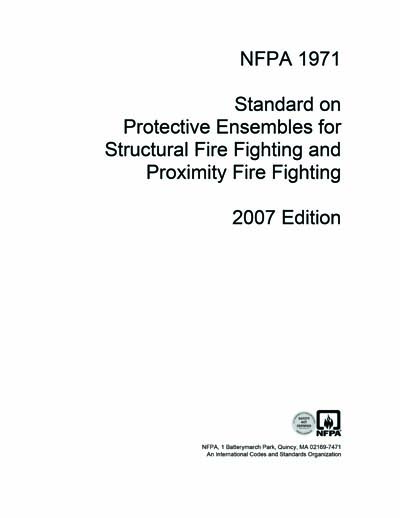Historical
NFPA 1971-2007
NFPA 1971: Standard on Protective Ensembles for Structural Fire Fighting and Proximity Fire Fighting, 2007 Edition
1.1* Scope. 1.1.1 This standard shall specify the minimum design, performance, testing, and certification requirements for structural fire fighting protective ensembles and ensemble elements that include coats, trousers, coveralls, helmets, gloves, footwear, and interface components. 1.1.2 This standard shall specify the minimum design, performance, testing, and certification requirements for proximity fire fighting protective ensembles and ensemble elements that include coats, trousers, coveralls, helmets, gloves, footwear, and interface components. 1.1.3* This standard shall also specify additional optional requirements for structural fire fighting protective ensembles and proximity fire fighting protective ensembles that will provide limited protection from specified chemicals, biological agents, and radiological particulates (CBRN) terrorism agents. 1.1.3.1* This standard shall establish requirements for a single exposure wearing of protective ensembles for limited protection from specified CBRN terrorism agents. 1.1.4 This standard shall specify requirements for new structural fire fighting protective ensembles, new proximity fire fighting protective ensembles, or new elements for both ensembles. 1.1.5* This standard shall not specify requirements for any accessories that could be attached to the certified product, but are not necessary for the certified product to meet the requirements of this standard. 1.1.6 Other than for the certification of structural or proximity protective ensembles to the optional CBRN requirements, this standard shall not specify the respiratory protection that is necessary for proper protection with both protective ensembles. 1.1.7 Certification of compliant structural fire fighting protective ensembles, compliant proximity fire fighting protective ensembles, and compliant elements of both ensembles to the requirements of this standard shall not preclude certification to additional appropriate standards where the ensemble or ensemble element meets all the applicable requirements of each standard. 1.1.8 This standard shall not be construed as addressing all of the safety concerns associated with the use of compliant protective ensembles or ensemble elements. It shall be the responsibility of the persons and organizations that use compliant protective ensembles or ensemble elements to establish safety and health practices and determine the applicability of regulatory limitations prior to use. 1.1.9 This standard shall not be construed as addressing all of the safety concerns, if any, associated with the use of this standard by testing facilities. It shall be the responsibility of the persons and organizations that use this standard to conduct testing of protective ensembles or ensemble elements to establish safety and health practices and determine the applicability of regulatory limitations prior to using this standard for any designing, manufacturing, and testing. 1.1.10 Nothing herein shall restrict any jurisdiction or manufacturer from exceeding these minimum requirements.
Content Provider
National Fire Protection Association [nfpa]






